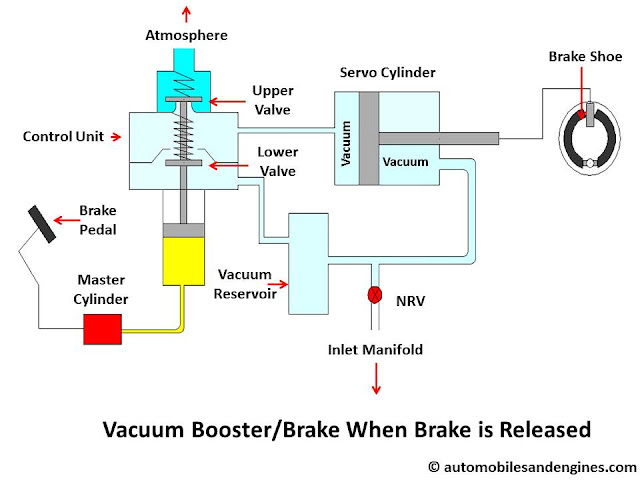Hello friends,
In this article we will learn about vacuum booster or vacuum brake system. In our previous articles we have discussed about disc brake and drum brake. Both of these braking system are mechanically operated or the braking force applied by the driver itself. But this statement is partially true because as the size of the vehicle increases, the amount of force required to actuate the brake is also increases. It is impossible for a human to apply brake without use any external device or booster.
When we required this external device the brake is known as power brake. Vacuum brake is one of the most popular power braking system which can be equipped with both disc and drum brake. There are many other types of brake like power brakes available like hydraulic brake, air brake etc.
This braking system have minimum lag time compare to other braking system due to which it is mostly used in trains.
Vacuum Brake:
Construction:
Vacuum booster have following parts arranged as shown in diagram.
Servo Cylinder:It is a simple piston cylinder arrangement in which one side of the piston rod is connected with the brake shoe. The piston is subjected to vacuum at both side in brake released position. When the brake is applied one side of the piston is exposed to atmosphere due to which a immediate braking force applied to piston which push the brake shoe.
Vacuum Reservoir:When the engine is in running position the vacuum in servo cylinder is created by inlet manifold but when the engine is stopped the vacuum reservoir is used to create vacuum in servo cylinder.
Control Unit:The control unit is used to apply brake. It is also a piston cylinder arrangement in which the upper valve is used to connect atmosphere to the servo cylinder and the lower valve is used to connect vacuum reservoir to servo cylinder. When the brake is applied the upper valve is in open position while the lower one is in closed position.
NRV: NRV which mean non return valve is used to connect servo cylinder to inlet manifold which allow only one sided flow of air from servo cylinder to inlet manifold.
Master Cylinder:Master cylinder is same as used in hydraulic brake which is used to operate the control unit.
Working:
Its working can be easily understood by following points.

- When the brake is in release position both side to servo cylinder is exposed to vacuum. The upper valve of the control unit is in closed position while the lower valve is in open position.
- Now when the driver press the brake pedal, the master cylinder comes into action which pushes the piston of control unit in upward direction. This movement of piston opens the upper valve of control unit and simultaneously closes the lower one.
- The opening of upper valve allows entering air into the servo cylinder left side through control unit. This will create a differential pressure in servo unit. This will pushes the servo piston at right side thus applied brake.
- This arrangement of vacuum booster considerably reduces the effort applied by the driver and whole braking force is applied by the vacuum.
Vacuum brake is mostly used in railway as an alternative of air brake.
This is all about vacuum booster brake. If you have any query regarding this article, ask by commenting. If you like this article, don’t forget to share it on social networks. Subscribe our website for more informative articles. Thanks for reading it.



thank you so much . can i have the pdf